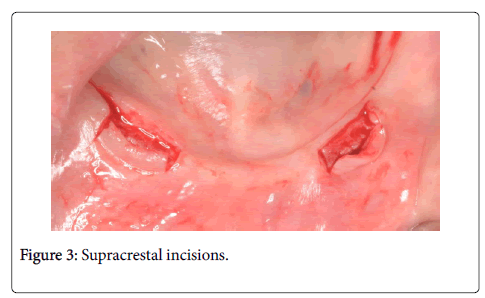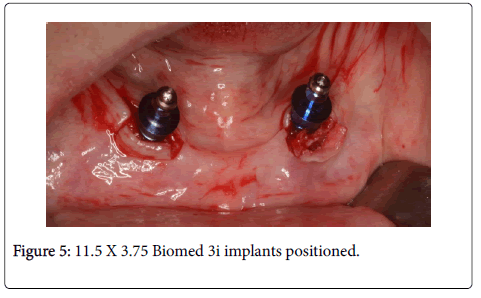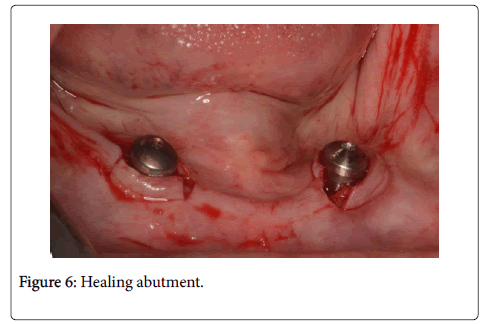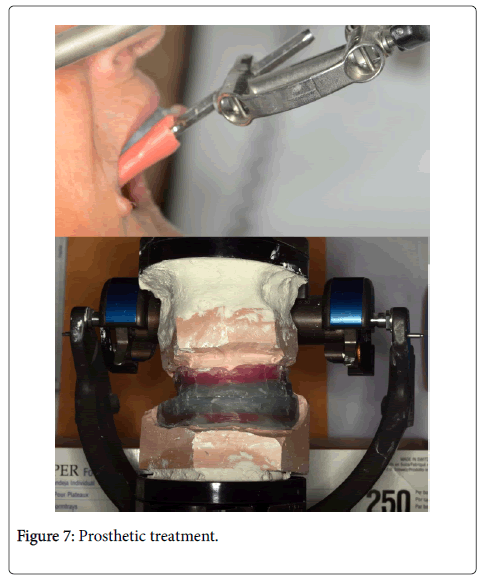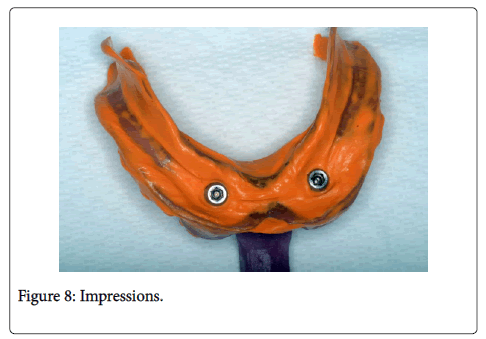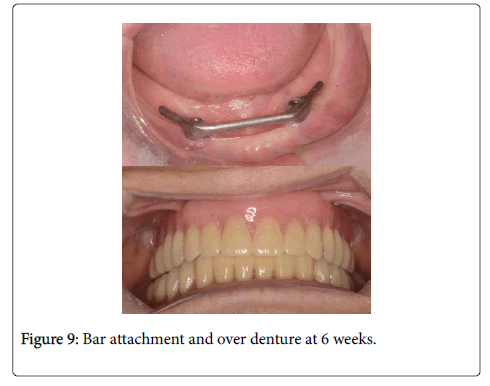Case Report Open Access
Two Implants in a Severely Resorbed Mandible: A Case Report of Early Loading
Carmen López Carriches*Department of Oral Surgery, School of Dentistry, Universidad Complutense de Madrid, Spain
- *Corresponding Author:
- Carmen López Carriches
C Rey Francisco, 11-Bajo Izda
28008 Madrid, Spain
Tel: 91 394 1964
E-mail: maclopez@pdi.ucm.es
Received Date: December 29, 2016; Accepted Date: January 18, 2017; Published Date: January 25, 2017
Citation: Carriches CL (2017) Two Implants in a Severely Resorbed Mandible: A Case Report of Early Loading. J Interdiscipl Med Dent Sci 5: 207. doi:10.4172/2376-032X.1000207
Copyright: © 2017 Carriches CL. This is an open-access article distributed under the terms of the Creative Commons Attribution License, which permits unrestricted use, distribution, and reproduction in any medium, provided the original author and source are credited.
Visit for more related articles at JBR Journal of Interdisciplinary Medicine and Dental Science
Abstract
Bone resorption often prevents elderly patients from wearing complete mandibular over dentures. This has a negative impact on the quality of life of patients, since it affects their speech, chewing ability and social relationships. Implant-supported over dentures have been proven to be superior to conventional dentures, both in terms of retention and stability. We report the case of an 82 year-old woman with a severely resorbed mandible that was rehabilitated with a 2-implant supported mandibular over denture. According to the reviewed literature, 2-implant over dentures is the preferred treatment for elderly patients with bone resorption due to its simplicity and reliability in the long-term.
Keywords
Dental implants; Over denture; Early loading; Elderly
Introduction
The increase in life expectancy has caused that many elderly patients have retention problems with their conventional dentures due to severe bone resorption. This has deleterious effects on their quality of life, as patients have difficulties in eating and speaking.
Two-implant-supported mandibular over dentures show good acceptance among elderly patients, since it is a minimally invasive intervention with lower risks than more complex therapies and it may be the only option in case of severe bone resorption [1].
A mandibular over denture retained by two splinted implants with bar improves retention, chewing experience and patient satisfaction [2].
A thorough clinical and radiographic study is performed to learn about the health status of the patient and the state of the bone.
Case Presentation
An 82-year old healthy female patient, with no medical history of interest. The patient, who wears a complete upper and lower denture, reports lack of retention, pain, eating and speech difficulties (Figure 1).
Extra oral exploration reveals reduced facial height, relative prognathism and collapse of lower facial soft tissue with the consequential altered appearance. Intraoral examination shows complete edentulism.
A CT scan of the mandible was ordered in order to measure the inter foraminal bone. The CT scan shows the height, width and bone density of the mandible (Figure 2). Treatment plan: Informed consent. Implant surgery, six-week loading.
The implants were inserted using the following procedure: Local anaesthesia (articain 40/0.005 mg/ml). Supracrestal reduced incisions with buccal flap (Figure 3). Preparation of the bone at the level of the canines using the surgical guide with implant drills: Pointed Starter Drill, Twist Drill 2 mm and Twist Drill 2.75 mm using direction indicators (Figure 4) and the two 11.5 × 3.75 Biomed 3i implants insertion, with primary stability (45 Nc) (Figure 5). Healing abutments were mounted in order to avoid a second surgery (Figure 6).
The patient was prescribed with antibiotics for one week (oral amoxicillin 750 mg, 1/8 h), antiinflammatory drugs (ibuprofen 600 mg, 1/8 h for 2-4 days) and analgesics if needed (paracetamol).
Four weeks later the prosthetic treatment is initiated. Models were mounted using the face bow and semi adjustable articulator (Kavo ®). The wax try-in was delivered by the laboratory (Figure 7). Once the wax try-in was approved, implant impressions were taken using an open-tray technique and fluid silicone to make the bar (Figure 8). The bar attachment and over denture were placed at 6 weeks after implant insertion (Figure 9). A bilaterally balanced occlusal model was used to better distribute stress and get better stability. The patient was shown how to insert and remove it, with special focus on hygiene. Follow-up visits were performed at one week, one month, six months and 12 months.
Discussion
In 2002 the expert committee that conducted the McGill Consensus statement established the two-implant-supported over denture as the treatment of choice for edentulous mandibles [3]. In 2009, The York Consensus validated this statement [4,5].
From the cost-benefit standpoint, the over denture supported on two interforaminal implants option is a reliable treatment option and is the treatment of choice for many surgeons [6].
There is no consensus about the different attachment systems. The choice of the attachment system depends on the experience of the clinician [7]. The bar can be used for primary splinting of the implants to minimize axial loads on implants [8]. The bar attachment could be preferable for cases with short implants or low bone quality [7]. Some authors have reported that the bar attachment needs less prosthetic maintenance and even patients are more satisfied with the retention achieved by the bar [9].
The locator system yields excellent clinical outcomes [10], although it may be difficult to use it in very elderly patients [11].
Elderly patients are more likely to agree to undergo this kind of surgery because it is simple; it improves their overall function and quality of life.
Many studies have reported an overall implant survival rate close to 100% for conventional, early and immediate protocols [12,13] and no differences were either observed as to the attachment system [14]. And the implant survival rate is not depending on the number of implants [15].
Conclusion
The use of two interforaminal implants to retain a mandibular over denture is a cost-effective treatment option for the completely edentulous patient.
Conflict of Interest
The author declares that she has no competing interests.
References
- Spitzl C, Proschel P, Nat R, Wichmann M, Heckmann S (2012) Long-term Neuromuscular status in overdenture and complete denture patients with severe mandibular atrophy. Int J Oral Maxillofac Implants 27:155-161.
- NetoAF, Pereira BMDF, XitaraLR, GermanoRA, RibeiroMJA, et al. (2012) The influence of mandibular implant-retained overdentures in masticatory efficiency. Gerodontology 29:e650-e655.
- Feine JS, Carlsson GE, Awad MA (2002) The McGill consensus statement on overdentures. Mandibular two-implant overdentures as first choice standard of care for edentulous patients. Gerodontology19:3-4.
- British Society for the Study of prosthetic dentistry (2009) The York consensus statement on implant-supported overdentures. Eur J ProsthodontRestor Dent 17:164-165.
- Thomson JM, Kelly SA, Bendkowski A, Ellis JS (2012) Two implant retained overdentures, A review of the literature supporting the McGill and York consensus statements. J Dent40:22-34.
- Perdijk FBT, Meijer GJ, Bronkhorst, Koole R (2011) Implants in severely resorbed mandibles: whether or not to augment? What is the clinician´s preference? Oral MaxillofacSurg 15:225-231.
- AratBS, Baykasoglu C, Kutay O, Mugan A (2015) Effect of attachment types and number of implants supporting mandibular overdentures on stress distribution: A computed tomography-based 3D finite element analysis. J Biomech 48:130-137.
- Burns DR, Unger JW, Coffey JP (2011) Randomized, prospective, clinical evaluation of prosthodontic modalities for mandibular implant overdenture treatment. J Prosthet Dent 106:12-22.
- Stoumpis C, Kohal J (2011) To splint or not to splint oral implants in the implant-supported overdenture therapy? A systematic literature review. J Oral Rehabil38: 857-869.
- Cakarer S, Can T, Yaltirik M, Keskin C (2011) Complications associated with the ball, bar and locator attachments for implant-supported overdentures. Med Oral Patol Oral Cir Bucal 16:e953-e959.
- Müller F, Duvernay E, Loup A, Vázquez, L, Herrmann FR, et al. (2013) Implant-supported mandibular overdentures in very old adults,arandomized controlled trial. J Dent Res 92: 154S-160S.
- Attard N, Zarb G (2005) Immediate and early implant loading protocols: A literature review of clinical studies. J Prosthet Dent 94:242-58.
- Roe P, Kan JYK, Rungcharassaeng K, Lozada JL (2011) Immediate loading of unsplinted implants in the anterior mandible for overdentures: 3-year results. Int J Oral Maxillofac Implants 26:1296-1302.
- Kim HY, Lee JY, Shin SW, Bryant SR (2012) Attachment systems for mandibular implant overdentures: a systematic review. J AdvProsthodont4:197-203.
- Lee JY, Kim HY, Shin SW, Bryant SR (2012) Number of implants for mandibular implant overdentures: a systematic review. J AdvProsthodont4:204-209.
Relevant Topics
- Cementogenesis
- Coronal Fractures
- Dental Debonding
- Dental Fear
- Dental Implant
- Dental Malocclusion
- Dental Pulp Capping
- Dental Radiography
- Dental Science
- Dental Surgery
- Dental Trauma
- Dentistry
- Emergency Dental Care
- Forensic Dentistry
- Laser Dentistry
- Leukoplakia
- Occlusion
- Oral Cancer
- Oral Precancer
- Osseointegration
- Pulpotomy
- Tooth Replantation
Recommended Journals
Article Tools
Article Usage
- Total views: 8018
- [From(publication date):
February-2017 - Apr 04, 2025] - Breakdown by view type
- HTML page views : 7120
- PDF downloads : 898



